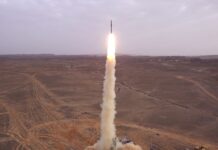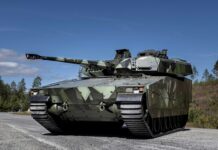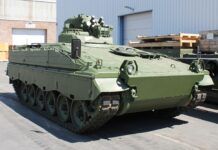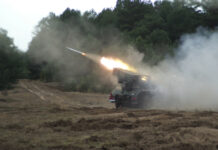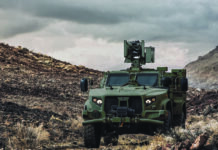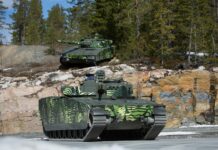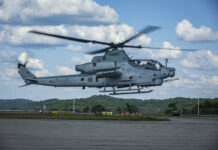After many years of neglect, the Armed Forces of the Slovak Republic finally have a chance to obtain modern Armoured Fighting Vehicles (AFV). In two procurement programmes, the Ministry of Defence plans to purchase 228 tracked and 500 wheeled armoured vehicles in different combat and combat support variants.
Since 1993, when the Armed Forces of the Slovak Republic (Ozbrojené sily Slovenskej republiky, OS SR) were established, the backbone of their mechanised infantry units has consisted not only of the BVP-2 Infantry Fighting Vehicles (IFVs), but also of the older BVP-1s. Today, these vehicles are still operated by the 11th, 12th, and 13th Mechanised Battalion within the 1st Mechanised Brigade, as well as by the 21st and 22nd Mechanised Battalion attached to the 2nd Mechanised Brigade.
The unfavourable situation in the fleet of Slovak tracked armoured fighting vehicles was only partially and provisionally rectified in recent years with the introduction of 17 BVP-M infantry fighting vehicles and 18 BPsVI Armoured Reconnaissance Vehicles (ARVs). Both types were created by rebuilding the BPzV Svatava ARV, which was the last variant of the BVP-1 IFV produced in Czechoslovakia between 1988 and 1990. Hence, despite their age, they were among the newest tracked armoured vehicles in the armament of the OS SR.
The main difference between the BVP-M and BPsVI vehicles lies in the Intelligence, Surveillance, Target Acquisition, Reconnaissance (ISTAR) equipment carried by the latter and in the variant of the TURRA 30 unmanned weapon station, which has a COAPS commander panoramic sight manufactured by Elbit Systems on the BVP-M vehicle. The Slovak companies KONŠTRUKTA – Defence, EVPÚ and MSM LAND SYSTEMS participated in the production and assembly of upgraded vehicles which took place between 2016 and 2019. While the BVP-Ms were introduced into the inventory of the 13th Mechanised Battalion, the BPsVIs serve with the ISTAR Battalion of the 2nd Mechanised Brigade. The former unit fulfills the duties within the NATO Readiness Initiative.
Unsuccessful Procurement
The top priority of the Land Forces of the OS SR is the establishment of a heavy mechanised brigade according to the NATO Capability Targets 2017. The formation will be based on the current 1st Mechanised Brigade with three mechanised infantry battalions that will be complemented by:
- a tank battalion
- an ISTAR battalion
- a self-propelled artillery battalion
- a radiation, chemical and biological defence battalion
- a command support battalion
- a combat service support battalion
- a logistic battalion
- an engineer battalion
- a ROLE2E field hospital
- a CIMIC/PSYOPS centre
- a military police company
Despite the importance of this commitment, not much has been done in the area of acquisition of the main type of armament for the brigade – the new tracked IFV. Instead, at its meeting on 15 November 2017, the Slovak Government approved the purchase of 8×8 (81 units of BOV 8×8) and 4×4 (404 vehicles BOV/VTV 4×4) wheeled armoured vehicles for the OS SR.
The former materialised in the form of the VYDRA IFV which was a combination of the Finnish AMV XP 8×8 SK chassis with the Slovak TURRA 30 remote-controlled weapon station. According to the plans at the time, the BOV 8×8 vehicles were to be used to arm three medium mechanised battalions. However, from the outset, the BOV 8×8 project faced harsh criticism from the political opposition and security analysts who blamed it for several shortcomings, including minimal transparency in the chosen method of acquisition. On the other hand, the Ministry of Defence of the Slovak Republic had consistently rejected these allegations and insisted that the vehicle meets all the requirements of the OS SR. In November 2018, the sole VYDRA prototype was bought by the Ministry of Defence for €4.3M. This step was to be followed by a decision of the Slovak Government to commence serial production. However, the then Government did not make such a decision and the new leadership of the Ministry of Defence formed after the elections in February 2020 canceled the project.
Compared to the BOV 8×8 project, the BOV/VTV 4×4 vehicles were due to be purchased in the frame of an international public tender. The Military Technical and Testing Institute Záhorie (Vojenský technický a skúšobný ústav Záhorie, VTSÚ) evaluated armoured vehicles of potential candidates to verify their technical specifications. Thus, during 2017 and 2018, the VTSÚ performed trials of the following types at the testing range at Záhorie:
- COBRA II
- EAGLE IV
- EJDER YALCIN
- PATRIOT I
- DINGO 2
- AJBAN 440A
- ALIGATOR MASTER II
- SHERPA Light
- GERLACH
- PERUN 4×4.
According to the original plan, out of a total of 404 units, the Ministry of Defence planned to procure 327 VTV 4×4 multi-purpose tactical vehicles with Level 2 ballistic protection and 77 BOV 4×4 combat armoured vehicles with Level 3 ballistic protection according to STANAG 4569. Both types were to meet Level 2a/2b mine protection according to STANAG 4569. Their transport capacity was set to be four to six soldiers. The basic armament was to feature a .50 Browning or 7.62×51 mm machine gun in a mechanical turret or remote-controlled weapon station, an automatic grenade launcher or a launcher for four anti-tank guided missiles.
The tender in a slightly modified form was finally announced in June 2019. The Ministry of Defence requested the delivery of up to 424 VTV 4×4 vehicles with Level 3 ballistic protection and Level 2a/2b mine protection according to STANAG 4569. The armoured vehicle was to be capable of transporting at least five persons. Out of the total, 20 VTV 4x4s were to be delivered to the Ministry of the Interior.
However, the tender faced public criticism in that its requirements were tailored to a single pre-selected bidder. In early July 2019, the Public Procurement Office (Úrad pre verejné obstarávanie) launched an audit of the tender procedure and in November of the same year ordered the Ministry of Defence to cancel the purchase of the vehicles. The Ministry initially filed an appeal which was later withdrawn after the change of its leadership following the election in February 2020. Thus, the VTV 4×4 procurement programme was also cancelled.
Weaponry for the Heavy Brigade
Therefore, in early 2021, of the priority armament projects for the heavy mechanised brigade, only the purchases of medium and heavy trucks, as well as ZUZANA 2 self-propelled howitzers, were satisfactorily carried out. In the meantime, with the BOV 8×8 and VTV 4×4 procurement projects in ashes, the Ministry of Defence re-evaluated its acquisition programmes and put emphasis on the purchase of the tracked infantry fighting vehicles within the frame of the PBV (Pásové bojové vozidlo – Tracked Combat Vehicle) programme. Among the first steps in this process was market research. Correspondingly, the Ministry began preliminary negotiations with selected companies, collecting information and preliminary offers. This was accompanied by practical tests of respective armoured tracked vehicles at the VTSÚ during spring 2021.
The first in the line was the LYNX KF41 manufactured by Rheinmetall Landsysteme GmbH from Germany. The presentation held in March aimed to present the technical characteristics, functional parameters and provide practical demonstrations in driving and shooting. The event also included talks with representatives of Rheinmetall about possible ways of involving Slovak companies in cooperation in the production and delivery of new tracked armoured vehicles for the OS SR, as well as a presentation of the current production capabilities of the state-owned company DMD Holding.
During the next month, the testing range at the VTSÚ was visited by ASCOD 42 offered by General Dynamics European Land Systems-Santa Bárbara Sistemas SA. Negotiations were again held between officials of the Ministry of Defence and the manufacturer’s representatives on the production and delivery of new infantry fighting vehicles using the capacities of the Slovak defence industry. In June, a practical presentation and evaluation of the last contender took place on the VTSÚ polygon. Unlike previous companies, BAE Systems Hägglunds AB brought from Sweden to Slovakia three CV90 vehicles in the APC, IFV and Fire Support Vehicle versions.
Between 2022 and 2030, the Ministry of Defence plans to procure a total of 228 armoured tracked vehicles in two stages and in two basic sub-variants: PBOV (Pásové bojové obrnené vozidlo – Tracked Combat Armoured Vehicle) and POV (Pásové obrnené vozidlo – Tracked Armoured Vehicle). While the former will serve primarily as the platform for the IFV, the latter will form the basis for a line of combat support vehicles. Originally, it was expected that three mechanised infantry battalions would be fully equipped with PBOV and POV vehicles. However, in order to save financial costs, some of the originally planned modifications (such as the medical evacuation vehicle) will be replaced by the wheeled BOV 8×8 platform.
According to the requirements of the OS SR, the IFV will comprise a crew of three, a troop compartment for at least seven soldiers, the main gun in calibre 30 to 40 mm, a 7.62 mm coaxial machine gun and an anti-tank guided missile system. The vehicle will meet the requirement for carrying supplies for a minimum of one day of combat operations without the need for resupply.
The actual acquisition is going to be handled as government-to-government procurement. Thus, the Ministry of Defence sends the Request for Government Proposal to countries able to ensure the supply of new tracked armoured vehicles through national producers. Upon receipt of the responses, these offers will be evaluated and the results will be submitted to the Slovak Government for a decision on negotiations with the specific country in order to reach agreement. The evaluation of the submitted offers – a feasibility study for the procurement of PBOV and POV vehicles, together with their technical parameters and a timetable for their procurement – shall be provided to the Slovak Government by 30 June 2022.
In the first phase of the project between 2022 and 2026, the intention is to arm three mechanised infantry battalions of the 1st Mechanised Brigade and the Training and Mobilisation Replenishment Base at Martin by 2026. The total estimated cost of the first phase of the PBV programme is approximately €1.739Bn, including VAT, of which the cost of 156 vehicles is some €1.512Bn, including VAT.
BOV 8×8 Project Relaunched
The Ministry of Defence restarted the BOV 8×8 (Bojové obrnené vozidlo 8×8 – Combat Armoured Vehicle 8×8) project roughly around the same as the PBV project. The main purpose of the programme is to equip a medium mechanised infantry battalion designated for operations within the frame of the NATO Readiness Initiative. At the same time, the BOV 8×8 in combat support and service support versions will be introduced into the inventory of the heavy mechanised brigade.
The basic combat version of the BOV 8×8 will be a wheeled IFV with a crew of three, a troop compartment for at least seven soldiers, a 30 mm main gun, a 7.62 mm coaxial machine gun and an anti-tank guided missile system. Taking into account the budgetary possibilities and priorities of the Ministry of Defence, deliveries of individual versions of BOV 8×8 will be carried out in phases. The acquisition is currently expected to take place in five stages, during which a total of 500 BOV 8×8 vehicles in 20 variants will be purchased.
The initial intention is to arm two medium mechanised infantry battalions of the Land Forces of the OS SR with 76 BOV 8×8 vehicles in the first phase of procurement between 2023 and 2025. The cost estimate for the first stage of the project is approximately €323M, including VAT (the estimated price for actual vehicles is roughly €296M, including VAT). The estimated costs also include the price of initial logistic support, training aids, ammunition and infrastructure required for the storage, operation and maintenance of the new vehicles.
The Ministry of Defence is obliged to provide the Government with an evaluation of the submitted offers (a feasibility study for the procurement of BOV 8×8 vehicles with technical parameters of individual variants and a timetable for their procurement) until 31 March 2022.
The procurement process in the following phases will depend on the production capabilities of the selected supplier and the allocated and approved budget of the Ministry of Defence. Each procurement phase will be subject to its own approval process by the Slovak Government.
The BOV 8×8 acquisition is organised in the same way as the PBV programme. Therefore, this project will be also be handled as a government-to-government procurement process. The Ministry of Defence currently plans to approach suppliers from European Union Members, the US and the UK. The Ministry can therefore theoretically choose from a relatively wide range of wheeled armoured vehicles. However, the actual choice will be limited for a number of reasons.
According to the current OS SR requirements, the BOV 8×8 must be equipped with an amphibious capability, which is among the most significant factors limiting the selection of candidates. In addition, the sufficiently high level of involvement of domestic industry in the production of new vehicles will be required. The Security and Defence Industry Association of the Slovak Republic required the involvement of the Slovak defence industry in the procurement process to be at least 50 per cent, with the priority to manufacture the main sections of the vehicles directly on the territory of the Slovak Republic. In the end, the Slovak Government approved a minimum share of 40 per cent (identical participation is required at the PBV project as well). Therefore, it can be assumed that the Ministry will require the BOV 8×8 to be fitted with the local TURRA 30 weapon station. This may cause problems for potential suppliers who may not have sufficient time to integrate the weapon station into their vehicles due to the tight timeframe of the acquisition’s first stage.
Therefore, the main candidates include the AMV (AMV XP) produced by the Finnish company PATRIA and PANDUR II 8×8 from General Dynamics European Land Systems (GDELS). Both vehicles already exist in versions with the TURRA 30 weapon station, have an amphibious capability and, in addition, have a strong industry presence in Slovakia. The former has already participated in the original BOV 8×8 tender, where it was offered by the state-owned company KONŠTRUKTA – Defence in the VYDRA variant. The latter type was presented to Slovak officials for the first time in the IFV CORSAC 8×8 version already in 2016 by MSM Martin, the Slovak branch of the CZECHOSLOVAK GROUP holding, which in January 2015 acquired the exclusive right to promote, sell and maintain PANDUR II 8×8 armoured vehicles in the Czech Republic and other selected markets in Eastern Europe and Asia. The agreement with GDELS-Steyr also included rights for licensed production of the PANDUR II 8×8 in the Czech Republic and Slovakia.
Regardless, the situation of the Slovak state treasury will be the most critical aspect for the future of both PBV and BOV 8×8 programmes. Already in late August, the Ministry of Finance warned that, given the high amount of funds needed for the purchase, the acquisition of both armoured vehicles may substantially limit the consolidation of public finances in the post-COVID period.
The first stage of the acquisition of both PBV (152 vehicles) and BOV 8×8 (76 vehicles) was approved by the Slovak Government on 8 September 2021. Unlike the original proposal, the PBV series of vehicles will be purchased without four PBOV training vehicles in the first stage and one regular PBOV infantry fighting vehicle in the second stage.






